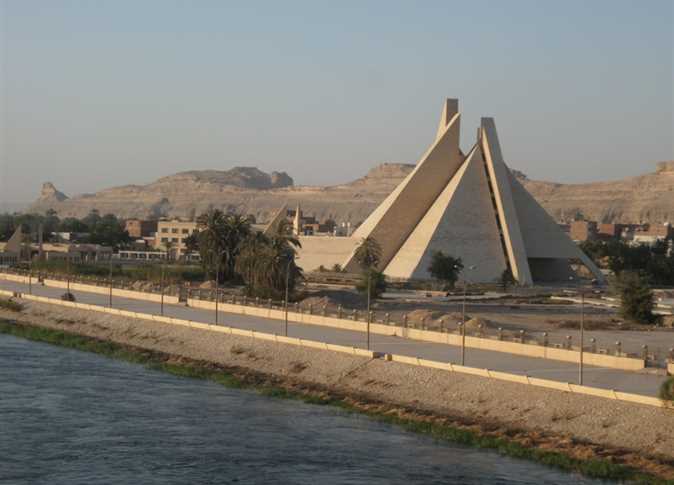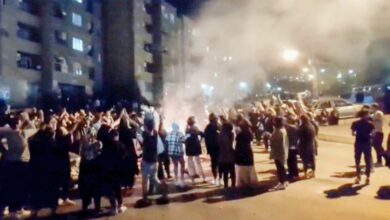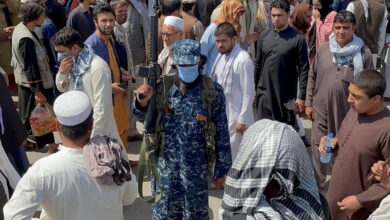Traditionally, the Franciscan Nun School in the Upper Egyptian tourist city of Luxor, by definition an apolitical institution, has refused to have any paintings or advertisements drawn on its walls.
Only recently, after the remarkable persistence of protesters in the city, has the school's administration accepted, or at least not objected to, the revolutionary graffiti coloring its walls.
Luxor might be geographically far from the political turmoil that rocked Cairo, Alexandria and Suez earlier this year (it is 671km south of the capital), but echoes of the revolution could still be heard loudly in the city.
During the revolution, protesters staged demonstrations and sit-ins supporting the revolution’s demands and an active revolutionary coalition was established. And today, people in Luxor – unlike most other Upper Egyptian cities – continue to feel that the revolution is a cause that must be supported.
“We are drawing graffiti over the walls to tell people that we are part of the revolution. Yes, we are really far from Cairo, but the revolution wasn’t meant just for Cairo. It is for Egypt as a whole,” says Eaad Oraby, a 21-year old student at Luxor’s Faculty of Fine Arts at South Valley University.
Oraby is a member of a group that sees graffiti as the best way to support the revolution’s demands. “It’s also a tool to tell people about the setbacks of the revolution, especially military trials [for civilians],” continues the young activist.
During the 18-day uprising that eventually forced former President Hosni Mubarak to step down, Egypt witnessed a boom in the use of graffiti as an artistic tool for political awareness and mobilization.
Along the corniche in the coastal city of Alexandria, freehand writings on buildings call on people to continue demonstrating, its squares filled with drawings mocking and attacking the ousted president.
This led Egypt’s most widely distributed cultural weekly newspaper, Akhbar Al-Adab, to devote an entire issue to graffiti, featuring the clamoring headline, “Long live the evanescent art.”
But the issue mostly dealt with the witty drawings in Cairo and Alexandria, leaving little room for graffiti from other areas like Luxor.
“We are not contesting anyone. But look at the drawings, anyone would feel the artistic soul inherent in them,” says Ammar Abu Bakr, a 31-year-old lecturer at Luxor’s Faculty of Fine Arts.
Abu Bakr, who is also an artist and photographer, led a group of young revolutionaries in reclaiming the walls of the city. “We wanted the walls to speak and shout about the revolution’s demands,” he explains.
For people in Luxor, drawing on walls is a sensitive issue. Whenever someone used to mention anything about writing on walls, people would become infuriated, says Abu Bakr.
“The word godran (walls) is generally associated in the minds of the residents with the walls of ancient temples," he says. "When we go and draw as a group, we keep telling people that we only draw on public walls rather than those of the temples.”
Tourism is the main income generator for Luxor and a vital source of income for the country as a whole. Being the site of the glorious ancient Egyptian city of Thebes, many consider Luxor the world's greatest open-air museum.
But graffiti is not new to the city. In fact, some historians traced the origin of graffiti back to the Luxor of the New Kingdom period. In his book, “The Graffiti of Pharaonic Egypt," Egyptologist Alexander Peden argues that temples are considered the earliest site for the art of graffiti.
However, modern Luxor has no experience with graffiti. “It’s a totally new phenomenon that appeared after the revolution,” says Abu Bakr.
Unlike in Cairo and Alexandria, where political graffiti infuriated authorities who responded by arresting artists and activists that dared to scrawl the political messages, no police harassment was reported regarding activists drawing graffiti in Luxor.
“The severest thing that happened to us was erasing our drawings, especially during the revolution, when secret police agents followed us around and erased our graffiti,” says Oraby.
Graffiti on the wall of the Habu Institute features former Interior Minister Habib al-Adly. His face is painted in dark colors and is full of cracks, next to the line, “Death for Habib al-Adly, the murderer,” written in neat, calligraphic style.
The unpopular Adly is not the only one whose face is drawn on the walls of Luxor. There is also Field Marshal Hussein Tantawi, Egypt’s de facto ruler. Tantawi is depicted in his uniform, enclosed within a black circle with a line across, next to a sentence reading, "No to military rule."
However, the graffiti portraits are not limited to unpopular political figures; some are also devoted to those whose causes the activists want to publicize, says Abu Bakr.
One example is Loai Nagati, an activist who is currently imprisoned by the military. Graffiti of his face is complemented by the words, “Freedom for Nagati” and “Give me liberty or give me death.”
But what is most striking about the Luxor graffiti are the short poems that are artistically written on the walls.
“We have chosen popular poets, like the prominent Abdel Rahman al-Abnoudy," adds Abu Bakr. "We write their poems against injustice. It’s wonderful to see how the people are reacting positively to such drawings."
On the wall of the Franciscan Nun School, an excerpt from a poem by Abnoudy reads:
The revolution is not a monopoly … It’s neither yours nor mine
It’s the revolution of he who faced the bayonet with his chest
And of he whom the bullet gouged his eye and he did cry
Photographs courtesy of Ammar Abu Bakr




